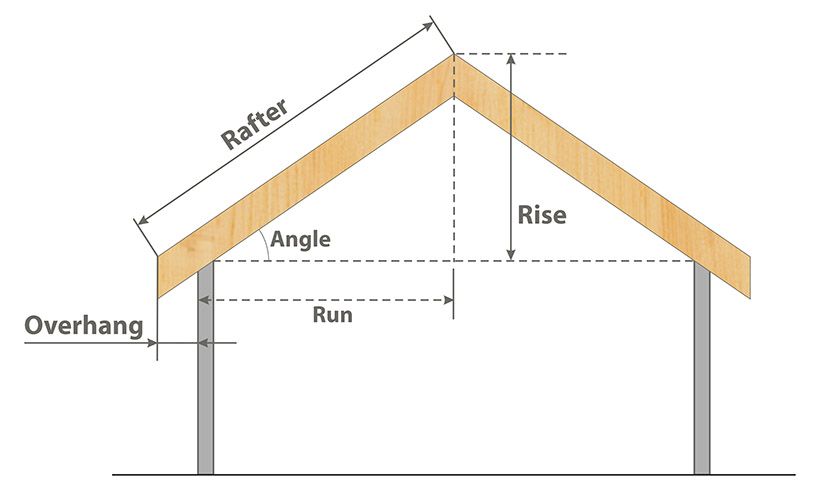Roof pitch – What is it?
The construction of the roof is the last stage of the house construction. But no less important than erecting walls. After all, the roof protects our home from the weather, and the aesthetic side of our home depends a lot on the type of roof.
So it happened, but flat roofs in our country can be found only at multi-storey buildings. Cottages and private houses are crowned with pitched roofs.
And one of the main calculation indicators in the construction of the house builders consider the angle of slope of the roof. Let’s consider how to correctly calculate this index, on what it depends and how it affects the construction of the roof in general. Try roof pitch calculator to find the slope of the roof.

Roof types and their dependence on the angle of slope.
Depending on the roof structure, several roof types are distinguished:
- A single pent roof. The roof is a sloping plane which lies on walls of different heights. Any material is suitable for such a roof.
- A double pent roof. It is a sufficiently robust and easy to install roof. It consists of two slopes. You can also choose absolutely any roofing material.
- The hipped roof. The roof is a construction in which several isosceles triangles with their tops are closed at one point. The rafting system for such a roof is quite complex, but it will require a minimum of consumables.
- It’s a hip roof. It has four slopes (two triangles and two trapezoidal ones). The tops of the roof are cut off. The roofs are very complex in design but very economical in terms of material consumption.
- The vaulted roof slab. Such roofs are made only of brick or stone. And so, as are very heavy, today in individual building almost are not used.
- Multi-pinned roofs. Very complex, but beautiful configuration with many jumpers and ribs.
- So, the roof is considered pitched if the angle of slope of the roof exceeds 10 degrees.
Very low price of gas blocks in Kiev region from PP Budpostach! Call our managers!
Allocate operated and not operated roof.
Non-operational roof is when there is almost no space between the roof itself and the upper ceiling, or intended this space for technical purposes. Such roofs can be flat roofs with an angle of slope from 2 to 7 degrees. In such roofs, the height of the space between the roof and the slab shall not exceed one and a half metres.
It is profitable to build flat roofs. Minimum cost for materials, work. The wind will not blow. Again, it is possible to provide additional space for rest. Lately it has been very popular to put green roofs on such roofs. But the rainfall on such a roof can ruin it.
So it’s not profitable to make completely flat roofs. Puddles of sediment will accumulate on the roof surface and destroy it.
In order to create a natural outflow of water, a layer of ceramite is poured onto flat roofs at a certain slope.
Rolled roofs, on the other hand, make it possible to use the space under the roof for the owner’s needs – attic, attic or even to equip them with thorough insulation and living rooms.
Factors on which the roof pitch is most dependent
The main factors affecting roof slope can be attributed to:
- Natural factors. The roof pitch depends on the climate in the area where the construction will take place. The wind puts enormous pressure on both the roof covering and the rafters in general. A slight increase in the gradient angle (by about 30 degrees) increases the wind load by almost 5 times. But a small angle can also play into the hands of the elements. In this way it will be easier for him to get into the roof through the joints of the covering and easily tear down the roof. Atmospheric precipitation can also have a destructive effect on the performance of the roof. However, with the right slope it is possible to avoid these troubles. Remember that the maximum snow load on the roof is achieved when the roof pitch angle of 30 degrees is maintained. And at 45 degrees, snow and rain will not stay on the roof at all…
- Roof pitch angle of metal tile roofs. The construction regulations define minimum slope values for each roofing material. They take into account the roof pitch and snow loads as well as wind conditions. For example, for tiled roofs, the minimum recommended roof pitch is 22 degrees, for slates it is 30 degrees.
Thus, it is obvious that if you are going to build a house in a region where rainfall is very frequent, the roof pitch of 45 degrees – just right. But if the rainfall is not so much, but the wind blows all year round, the optimal option – the roof with a slope of 30 degrees.
How do you calculate the angle of slope
How do you determine the roof slope that will be optimal for your new home?
Remember that the bigger the roof pitch, the more costs you will incur for the construction work.
The slope is calculated as the ratio of the ridge size to half the width of the building and multiplied by 100. Professional builders have their own instructions and calculations for calculating the roof pitch.
